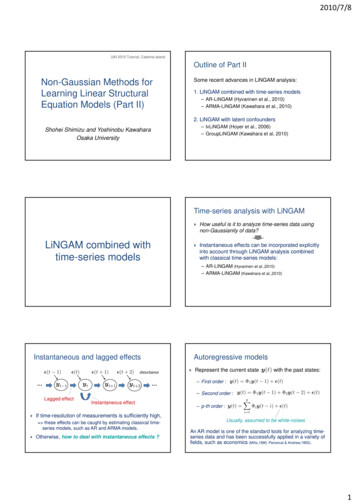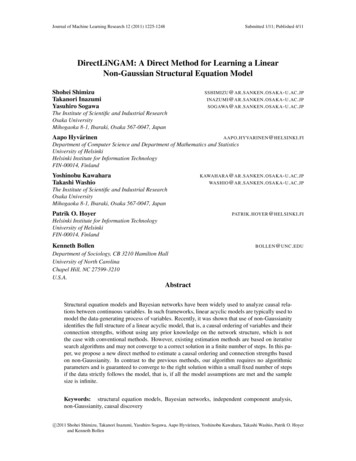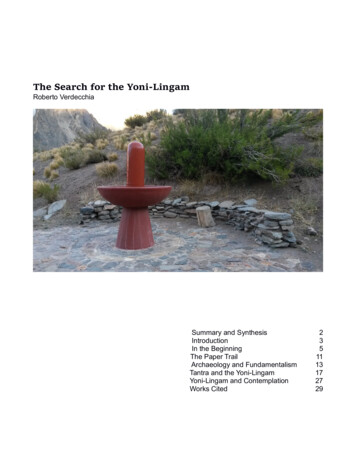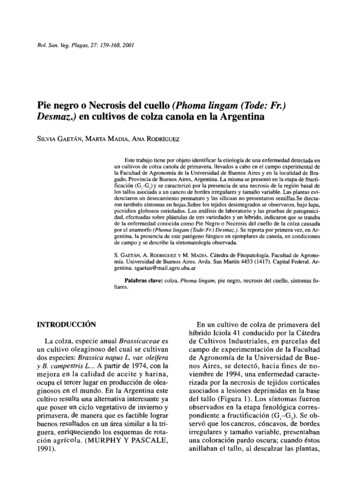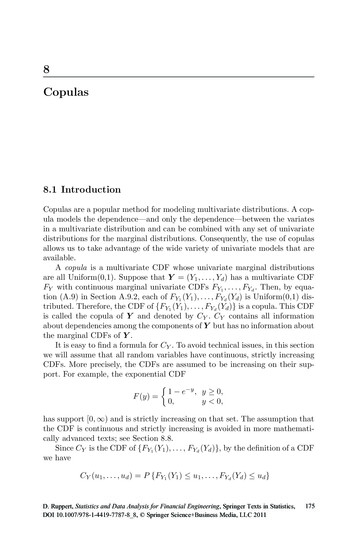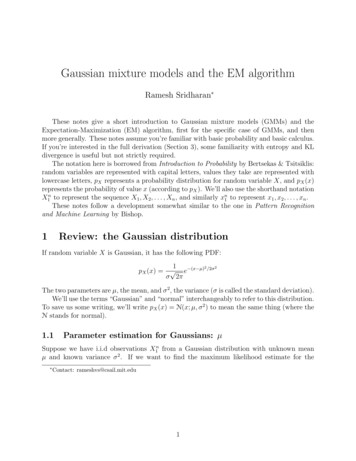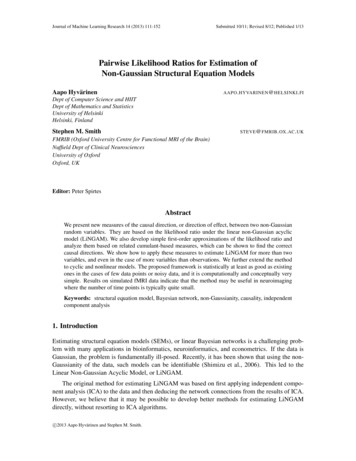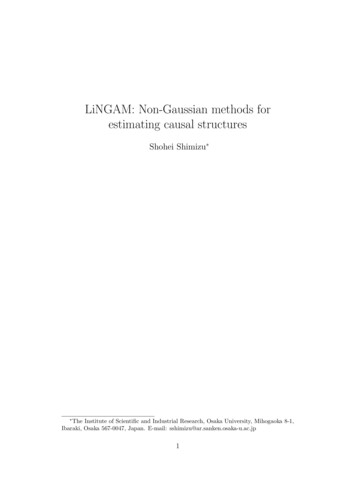
Transcription
LiNGAM: Non-Gaussian methods forestimating causal structuresShohei Shimizu The Institute of Scientific and Industrial Research, Osaka University, Mihogaoka 8-1,Ibaraki, Osaka 567-0047, Japan. E-mail: sshimizu@ar.sanken.osaka-u.ac.jp1
AbstractIn many empirical sciences, the causal mechanisms underlying various phenomena need to be studied. Structural equation modeling isa general framework used for multivariate analysis, and provides apowerful method for studying causal mechanisms. However, in manycases, classical structural equation modeling is not capable of estimating the causal directions of variables. This is because it explicitlyor implicitly assumes Gaussianity of data and typically utilizes onlythe covariance structure of data. In many applications, however, nonGaussian data are often obtained, which means that more informationmay be contained in the data distribution than the covariance matrixis capable of containing. Thus, many new methods have recently beenproposed for utilizing the non-Gaussian structure of data and estimating the causal directions of variables. In this paper, we provide anoverview of such recent developments in causal inference, and focus inparticular on the non-Gaussian methods known as LiNGAM.KeywordsCausal inference, Causal structure learning, Estimation of causal directions, Structural equation models, non-Gaussianity2
Contents1 Introduction42 Basics of causal inference2.1 Counterfactual model of causation . . . . . . . . . . . . . . .2.2 Structural equation models for describing data-generating processes . . . . . . . . . . . . . . . . . . . . . . . . . . . . . .2.3 SEM representation of causation . . . . . . . . . . . . . . . .2.4 Identifiability of average causal effects when the causal structure is known . . . . . . . . . . . . . . . . . . . . . . . . . .2.5 Identifiability of causal structures . . . . . . . . . . . . . . .2.5.1 Basic setup . . . . . . . . . . . . . . . . . . . . . . .2.5.2 A conventional approach . . . . . . . . . . . . . . . .2.5.3 A non-Gaussian approach . . . . . . . . . . . . . . .55.68.10111214163 LiNGAM173.1 Independent component analysis . . . . . . . . . . . . . . . . . 183.2 Identifiability of LiNGAM . . . . . . . . . . . . . . . . . . . . 194 Estimation of LiNGAM4.1 ICA-LiNGAM . . . . . . . . . . . . . . . . . . .4.2 DirectLiNGAM . . . . . . . . . . . . . . . . . .4.3 Improvements on the basic estimation methods4.4 Relation to the causal Markov condition . . . .4.5 Evaluation of statistical reliability . . . . . . . .4.6 Detection of violations of model assumptions . .5 Extensions of LiNGAM5.1 Latent confounding variables .5.2 Time series . . . . . . . . . .5.3 Cyclic models . . . . . . . . .5.4 Three-way data models . . . .5.5 Analysis of groups of variables5.6 Nonlinear extensions . . . . .5.7 Other issues . . . . . . . . . .6 Conclusion.21222327282828.2929303131323233333
1IntroductionIn many empirical sciences, the causal mechanisms underlying various natural phenomena and human social behavior are of interest and need to bestudied. Conducting a controlled experiment with random assignment is aneffective method for studying causal relationships; however, in many fields,including the social sciences (Bollen, 1989) and the life sciences (Smith, 2012;Bühlmann, 2013), performing randomized controlled experiments is oftenethically impossible or too costly. Thus, it is necessary and important todevelop computational methods for studying causal relations based on datathat are obtained from sources other than randomized controlled experiments. Such computational methods are useful for developing hypotheses oncausal relations and deciding on possible future experiments to obtain moresolid evidence of estimated causal relations (Maathuis et al., 2010; Pe’er andHacohen, 2011; Smith, 2012).A major framework for causal inference (Pearl, 2000) may be based on acombination of the counterfactual model of causation (Neyman, 1923; Rubin,1974) and structural equation modeling (Bollen, 1989). The counterfactualmodel describes causation in terms of the relationships between the variablesinvolved: generally speaking, if the value of a variable is changed and thatof some other variable also changes, the former is the cause and the latteris the effect. Structural equation models are mathematical models that canbe used to represent data-generating processes. Using structural equationmodels, one can mathematically represent the cause-and-effect relationshipsthat are defined by using the counterfactual model.Structural equation modeling provides a general framework for multivariate analysis and offers a powerful means of studying causal relations(Bollen, 1989; Pearl, 2000). However, in many cases, classical structuralequation modeling is not capable of estimating the causal directions of variables (Bollen, 1989; Spirtes et al., 1993; Pearl, 2000). A major reason for thisdisadvantage is that this method explicitly or implicitly assumes the Gaussianity of data, and typically utilizes only the covariance structures of datafor estimating causal relations. However, in many applications, it is commonfor non-Gaussian data to be obtained (Micceri, 1989; Hyvärinen et al., 2001;Smith et al., 2011; Sogawa et al., 2011; Moneta et al., 2013), which meansthat more information can be contained in the data distribution than in thecovariance matrix. Bentler (1983) proposed making use of non-Gaussianityof data for estimating structural equation models, although this had not beenextensively studied until recently.New methods have since been proposed for utilizing the non-Gaussianstructure of data and thereby estimating the causal directions of variables4
when studying causality (Dodge and Rousson, 2001; Shimizu et al., 2006).These methods have, in turn, led to the development of many additionalmethods, including latent confounder methods (Hoyer et al., 2008b; Shimizuand Hyvärinen, 2008), time series methods (Hyvärinen et al., 2010), nonlinear methods (Hoyer et al., 2009; Zhang and Hyvärinen, 2009b; Tillmanet al., 2010) and discrete variable methods (Peters et al., 2011a). Thesenon-Gaussian methods have been applied to the data studied in many fields,including economics (Ferkingsta et al., 2011; Moneta et al., 2013), behavior genetics (Ozaki and Ando, 2009; Ozaki et al., 2011), psychology (Takahashi et al., 2012), environmental science (Niyogi et al., 2010), epidemiology (Rosenström et al., 2012), neuroscience (Smith et al., 2011) and biology(Statnikov et al., 2012).In this paper, we provide an overview of such recent developments incausal inference. In Section 2 of this paper, we first briefly review the basicsof causal inference, including the counterfactual model of causation and itsmathematical representation, based on structural equation models. We thendiscuss recent developments in methods applied to estimating causal structures, focusing in particular on the non-Gaussian methods known as LinearNon-Gaussian Acyclic Models (LiNGAM). We explain the basic LiNGAMmodel in Section 3, its estimation methods in Section 4 and its extensionsin Section 5. Methods that form part of the LiNGAM group are capable ofestimating a much wider variety of causal structures than classical methods.2Basics of causal inferenceIn this section, we provide a brief overview of causal inference (Bollen, 1989;Spirtes et al., 1993; Pearl, 2000). For an in-depth discussion, refer to Pearl(2000).2.1Counterfactual model of causationWe begin by introducing the concept of individual-level causation (Neyman,1923; Rubin, 1974). Suppose that an individual named Taro is a patientwith a certain disease. We want to know if a particular medicine cures hisdisease. To this end, we compare the consequences of two actions: i) Havinghim take the medicine; and ii) Having him not take the medicine. SupposeTaro recovers after three days later if he takes the medicine, but does notrecover if he does not. Then, we can say that his taking the medicine causedhis recovery within three days. Therefore, in terms of Taro, if the value ofa binary variable x (1: takes the medicine, 0: does not take the medicine)5
is changed from 0 to 1, and that of a second binary variable y (1: recovers,0: does not recover) changes from 0 to 1, it means that Taro’s taking themedicine is the cause of his recovery.However, a problem arises in such a situation: it is not possible to observeboth of these consequences. This is because, once we observe the consequenceof Taro taking the medicine, we can never observe that of him not takingthe medicine. The former consequence is factual, since he actually took themedicine, while the latter is counterfactual, since it contradicts the fact. Itis therefore impossible to compare the two consequences and derive a causalconclusion based on the data of the individual Taro, and this is known as thefundamental problem of causal inference (Holland, 1986).Next, we introduce the concept of population-level causation (Neyman,1923; Rubin, 1974). Suppose that all the individuals in a population aresuffering from a certain disease. We want to know if a particular medicinewill cure the disease in this population. To determine this, we compare theconsequences of two actions: i) Having all the individuals in the populationtake the medicine; and ii) Having all the individuals not take the medicine.Suppose that the number of individuals who took the medicine and hadrecovered three days later is significantly larger than that of the individualswho did not take the medicine and recovered three days. Then, we can saythat taking the medicine caused recovery in three days in this population.Here, we encounter a similar problem as that in individual-level causation.That is, once we observe the consequence of all the individuals actually takingthe medicine, we can never observe the consequence of them not taking themedicine. However, although individual-level causation generally cannot bedetermined, fortunately, it is sometimes possible to determine populationlevel causation, as discussed below.2.2Structural equation models for describing datagenerating processesIn this subsection, we discuss structural equation models (SEMs) as a mathematical tool for describing the processes through which the values of variablesare generated (Bollen, 1989; Pearl, 2000). In structural equation modeling,special types of equations, known as structural equations, are used to represent how the values of variables are determined. An illustrative example ofa structural equation for the case described above is given byy fy (x, ey ),(1)where y denotes whether the disease is cured (1: cured, 0: not cured), xdenotes the presence or absence of medication (1: presence, 0: absence), and6
ey denotes all the factors other than x that could contribute to determiningthe value of y, even when x is held constant. Structural equations representmore than simply mathematical equality. In Eq. (1), the left-hand side of theequation is defined by the right-hand side, i.e., the value of y is completelydetermined by that of x and ey through the deterministic function fy .Similarly, when defining the structural equation relating to x, we obtaina full description of the data-generating process of the variables x and y, i.e.,their SEM, as follows:x exy fy (x, ey ),(2)(3)where ex denotes all the factors that could contribute to determining thevalue of x. In these equations, first the value of ex is somehow generated,and then the value of x is determined from that of ex by means of the identityfunction. Subsequently, the value of ey is somehow generated, and then thevalue of y is determined from that of x and ey through the function fy . Thevariables ex and ey are known as exogenous variables, external influences,disturbances, errors or background variables. The values of these variablesare generated outside of the model and their data-generating processes aredecided by the modeler not to be further modeled. In contrast, variableswhose values are generated inside the model, such as y above, are known asendogenous variables.In order to clarify the meanings of SEMs, the qualitative relations are often graphically represented by graphs called path-diagrams. Path-diagrams,also known as causal graphs, can be seen as representing causal structures.Causal graphs are constructed according to two rules (Bollen, 1989; Pearl,2000): i) Draw a directed edge from every variable on the right-hand side ofa structural equation to the variable on the left-hand side; and ii) Draw abi-directed arc between two exogenous variables if the values of these variables could be (partially) determined by a common latent variable; e.g., inthe example above, the level of severity of the disease could contribute todetermining both whether the medicine is taken and whether the disease iscured. Common latent variables such as these are called latent confoundingvariables, and cause the exogenous variables to be dependent. The associated causal graph of the SEM represented by Eq. (2)-(3) is shown in the leftof Fig. 1. Since x is determined by ex , and y could be determined by x andey , directed edges are drawn from ex to x, and from x and ey to y. Sincethere could be a common latent variable that contributes to determining thevalues of both x and y, a bi-directed arc is drawn between ex and ey .In general, a SEM is defined as a four-tuple consisting of i) endogenousvariables; ii) exogenous variables; iii) deterministic functions that define the7
structural equations relating the endogenous and exogenous variables; andiv) the probability distribution of the exogenous variables (Pearl, 2000). Theprobability distribution of the endogenous variables is induced by the deterministic functions and the probability distribution of the exogenous variables.We are able to make inferences on the SEM based on the distribution of theobserved variables among the exogenous and endogenous variables. In theexample above, the SEM given in Eq. (2)-(3), with the causal graph shownon the left of Fig. 1, consists of i) the endogenous variable y; ii) the exogenous variables ex ( x) and ey ; iii) the deterministic function fy ; and iv) theprobability distribution of the exogenous variables p(ex , ey ).2.3SEM representation of causationIn this subsection, we explain the SEM representation of population-levelcausation (Pearl, 2000). We first define interventions in SEMs. Interveningon a variable x means holding the variable x to be a constant, a, regardlessof the other variables, and this intervention is denoted by do(x a). Instructural equation modeling, this means replacing the function determiningx with the constant a, i.e., letting all the individuals in a population takex a (Pearl, 2000). Suppose that we intervene on x and fix x at a in theexample given in Eq. (2)-(3). We then obtain a new SEM, denoted by Mx a :x ay fy (x, ey ).(4)(5)As a result, the causal graph changes to that shown in the center of Fig. 1.The exogenous variable x becomes independent of the exogenous variableey , i.e., the bi-directed arc in the causal graph of the original SEM givenin Eq. (2)-(3) disappears, since x is forced to be a regardless of the othervariables. Note that we assume that, even if a function is replaced with aconstant, the other functions do not change, although this might be physicallyunrealistic in some cases. In our example, the revised SEM given in Eq. (4)(5) represents a hypothetical population, where all the individuals in thepopulation are forced to take x a, but the other function fy , which relatesx to y, does not change.Next, we define post-intervention distributions (Pearl, 2000). When intervening on x, the post-intervention distribution of y is defined by the distribution of y in the SEM after the intervention Mx a :p(y do(x a)) : pMx a (y).(6)In the example above, the post-intervention distribution of y (1: cured, 0:not cured) when fixing x at a (1: taking the medicine, 0: not taking the8
medicine) is given by the distribution of y in the post-intervened SEM Mx a ,for which the associated causal graph is shown in the center of Fig. 1.We can now provide the SEM representation of population-level causation(Pearl, 2000). If there exist two different values c and d, such that the postintervention distributions are different; that is,p(y do(x c)) ̸ p(y do(x d)),(7)we can say that x causes y in this population. In the example we are using,if p(y do(x 1)) ̸ p(y do(x 0)), we can say that taking the medicinepositively or negatively causes a cure in this population. Moreover, if p(y 1 do(x 1)) ( ) p(y 1 do(x 0)), we can say that taking the medicinepositively (negatively) causes, i.e., is effective (harmful) in curing the diseasein this population.A common method for quantifying the causal connection strength of xon y is to assess the following average difference (Rubin, 1974; Pearl, 2000):E(y do(x d)) E(y do(x c)),(8)which is called the average causal effect. This evaluates to what extent, onaverage, the value of y will change if the value of x is changed from c to d.Changing the value of x from c to d means that x is fixed at c, regardless ofthe variables that determine x, and the value is changed from c to d (Pearl,2000). As explained above, fixing x at c, regardless of the variables thatdetermine x, the process that is denoted by do(x c), means replacing thefunction determining x with c in the SEM.Although x and y are binary, purely for the purpose of illustration, weassume that the function fy , in the SEM of Eq. (2)-(3), is linear:x exy byx x ey ,(9)(10)where byx is constant. The post-intervened SEM Mx a takes the form:x ay byx x ey .(11)(12)Therefore, the average causal effect of x on y when x is changed from c to dis given byE(y do(x d)) E(y do(x c)) E(byx d ey ) E(byx c ey ) (13) byx (d c).(14)9
The expected average change in x is thus the difference between d and cmultiplied by the coefficient byx , while the post-intervened model My a shownon the right of Fig. 1 is written asx exy a.(15)(16)Then, the average causal effect of y on x when changing y from c to d isgiven byE(x do(y d)) E(x do(y c)) E(ex ) E(ex ) 0.(17)(18)This is reasonable, since y does not contribute to defining x in the originalSEM shown in Eq. (2)-(3) and on the left of Fig. 1.Structural equation models can also be used to represent individual-levelcausation. The key concept in such a situation is that different values of thevectors that collect exogenous variables can be seen as representing differentindividuals (Pearl, 2000).The values of ex and ey for Taro in the medicine cure example in Eq. (2)(3) are denoted by eTx aro and eTy aro , respectively. Furthermore, the valuesT arothat y would attain had x been fixed at d and c are denoted by yx dandT aroT aroT aroyx c . The values yx d and yx c are obtained as the solutions of the SEMsMx d with x fixed at d and Mx c with x fixed at c when the values of theexogenous variables ex and ey are eTx aro and eTy aro . The difference betweenT aroT aroyx dand yx cis thusT aroT aroyx d yx c fy (d, eTy aro ) fy (c, eTy aro ).(19)If there exist two different values, c and d, such that the difference is notzero, we can say that x causes y for Taro. This means that, if x for Taro ischanged from c to d, y for Taro increases by fy (d, eTy aro ) fy (c, eTy aro ). Thiscan be simplified to byx (d c) if fy is linear, which means that if x for Tarois changed from c to d, y for Taro increases by the difference between d andc multiplied by the coefficient byx .2.4Identifiability of average causal effects when thecausal structure is knownSo far, we have provided definitions for various causal concepts. We nowbriefly discuss the identifiability conditions required for average causal effectsto be uniquely estimated from the observed data when the causal structure10
is known. We consider the situation where E(y do(x)) is reduced to anexpression without any do(·) operators.In the simplest case, the relation of x and y is acyclic, i.e., there is nodirected cycle in the causal structure, and the exogenous variables are independent, which implies that there are no latent confounders:x exy fy (x, ey ),(20)(21)where exogenous variables ex and ey are independent, in contrast to theSEM in Eq. (2)-(3). If some latent confounders do exist, this means theexogenous variables are dependent. The causal structure of the model isshown on the left of Fig. 2. In this case, it can straightforwardly be shownthat E(y do(x)) E(y x) (Pearl, 1995). Following this, the average causaleffect is calculated by the difference between two conditional expectations:E(y do(x d)) E(y do(x c)) E(y x d) E(y x c).(22)We can also describe a more general case, where the additional variableszq (q 1, · · · , Q) exist. Assume that the causal relations of x, y and zq(q 1, · · · , Q) are acyclic, and their exogenous variables are independent. Itmust now be decided which of the variables zi should be observed and usedto identify E(y do(x)). A sufficient set of variables for this is that of theparents of x, i.e., the variables that have directed edges to x (Pearl, 1995).Then, the average causal effect can be estimated byE(y do(x d)) E(y do(x c)) Epa(x) [E(y x d, pa(x))] Epa(x) [E(y x c, pa(x))],(23)where pa(x) denotes the set of parents of x. If fy is linear, the average causaleffect can be simplified to the difference (d c) multiplied by the partialregression coefficient of x when y is regressed on x and its parents. Anexample of a causal structure is given on the right of Fig. 2, where observingz1 and z4 is sufficient. Further details regarding latent confounder cases canbe found in Shpitser and Pearl (2006, 2008). Once the causal structure isknown, in many cases it is possible to determine whether average causaleffects are identifiable, i.e., can be uniquely estimated from the observeddata.2.5Identifiability of causal structuresIn this subsection, we discuss the identifiability of causal structures, i.e.,under which model assumptions the causal structure of variables can be11
uniquely estimated based on the observed data. Model assumptions represent the background knowledge and hypotheses of the modeler and placeconstraints on the SEM. These assumptions can sometimes be tested to detect possible violations, although, as in any data analysis process, it wouldbe impossible to prove that they are true.2.5.1Basic setupWe first explain the basic setup for identifying causal structures (Pearl, 2000;Spirtes et al., 1993). We assume that the causal relations of the observedvariables are acyclic, i.e., there are no directed cycles or feedback loops in thecausal graph. Since the exogenous variables are independent, it is impliedthat there are no latent or unobserved confounding variables that causallyinfluence more than one variable. Although these assumptions may appearto be restrictive, it is possible to relax the two assumptions and develop moregeneral methods based on the information obtained from the basic setup.In this paper, the focus is on continuous variable cases. Although nospecific functional form is assumed for discrete-valued data, in most cases,linearity and Gaussianity are assumed for continuous-valued data (Spirteset al., 1993; Pearl, 2000). This assumption of linearity would, however, almostcertainly be violated when analyzing real-world data. Therefore, in theory,nonlinear approaches are probably more suitable for modeling the causalrelations of variables. However, it should be noted that, in practice, linearmethods can often provide better results when finding qualititative relationsincluding causal directions is necessary (Pe’er and Hacohen, 2011; Hurleyet al., 2012), since nonlinear methods usually require very large sample sizes.In the remainder of the paper, we mainly discuss linear methods, but alsorefer to their nonlinear extensions. In the following sections, we furthermoreshow that the assumption of Gaussianity actually limits the applicabilityof causality estimation methods, and that a significant advantage may beachieved by departing from this assumption.The basic model for continuous observed variables xi (i 1, · · · , d) istherefore formulated as follows: A causal ordering of the variables xi is denoted by k(i). With this ordering, the causal relations of the variables xi canbe graphically represented by a directed acyclic graph (DAG)1) , so that nolater variable determines, that is, has a directed path to, any earlier variablein the DAG. Further, we assume that the functional relations of the variablesare linear. Without loss of generality, the variables xi are assumed to havezero mean. We thus obtain a linear acyclic SEM with no latent confounders12
(Wright, 1921; Bollen, 1989):xi bij xj ei ,(24)k(j) k(i)where ei are continuous latent variables that are exogenous, i.e., are notdetermined inside the model, and bij are the connection strengths from xjto xi . The exogenous variables ei have zero mean and non-zero variance,and are independent of each other. The independence assumption betweenei implies that there are no latent confounding variables.In matrix form, the linear acyclic SEM with no latent confounders inEq. (24) can be written asx Bx e,(25)where the connection strength matrix B collects the connection strengths bij ,and the vectors x and e collect the observed variables xi and the exogenousvariables ei , respectively. The zero/non-zero pattern of bij corresponds tothe absence/existence pattern of the directed edges. That is, if bij ̸ 0,there is a directed edge from xj to xi , but if this is not the case, there is nodirected edge from xj to xi . Note that, due to the acyclicity, the diagonalelements of B are all zeros. It can be shown that it is always possible toperform simultaneous, equal row and column permutations on the connectionstrength matrix B to cause it to become strictly lower triangular, based onthe acyclicity assumption (Bollen, 1989). Here, strict lower triangularity isdefined as a lower triangular structure with the diagonal consisting entirelyof zeros.Examples of causal graphs for representing the linear acyclic SEMs withno latent confounders in Eq. (25) are provided in Fig. 3. The SEM corresponding to the left-most causal graph of the figure is written as e1x10 0 3x1 x2 5 0 0 x2 e2 .(26)e3x3x30 0 0In this example, x3 is in the first position of the causal ordering that causesB to be strictly lower triangular, x1 is in the second, and x2 is in the third,i.e., k(3) 1, k(1) 2, and k(2) 3. If we permute the variables x1 to x3according to the causal ordering, we obtain 0 0 0e3x3x3 x1 3 0 0 x1 e1 .(27)e2x2x20 5 013
It can be seen that the resulting connection strength matrix is strictly lowertriangular. There is no other such causal ordering of the variables that resultsin a strictly lower triangular structure in this example. In contrast, there aretwo such causal orderings in the center causal graph: i) k(1) 1, k(3) 2,and k(2) 3; and ii) k(3) 1, k(1) 2, and k(2) 3, since there is nodirected path between x1 and x3 .The goal of identifying causal structures under this basic setup is to estimate the unknown, B, by using only the data X, based on the assumption that X is randomly sampled from a linear acyclic SEM with no latentconfounders, as represented by Eq. (25) above. In other words, we aim todetermine which model is true among the class of linear acyclic SEMs withno latent confounders, assuming that the class includes the true one.2.5.2A conventional approachIn this section, we first discuss the identifiability problems experienced withconventional methods for estimating B of the linear acyclic SEM with nolatent confounders in Eq. (25). We say that B is identifiable if and onlyif B can be uniquely determined or estimated from the data distributionp(x). Once B is identified, we can estimate the causal structure from thezero/non-zero pattern of its elements, bij . The connection strength matrixB, together with the distribution of the exogenous variables p(e), induces thedistribution of the observed variables p(x). If p(x) are different for differentB, it follows that B can be uniquely determined.The causal Markov condition is a classical principle used for estimatingthe causal structure of the linear acyclic SEM with no latent confounders inEq. (25). For any linear acyclic SEM, the causal Markov condition holds2)(Pearl and Verma, 1991), as follows: Each observed variable xi is independentof its non-descendants in the DAG conditional on its parents, i.e., p(x) Πdi 1 p(xi pa(xi )). If Gaussianity of the exogenous variables is furthermoreassumed, conditional independence is reduced to partial uncorrelatedness.Thus, conditional independence between observed variables provides a clueas to what the underlying causal structure is.It is necessary to make an additional assumption, known as faithfulness(Spirtes et al., 1993) or stability (Pearl, 2000), when making use of the causalMarkov condition for estimating the causal structure. In this case, the faithfulness assumption means that the conditional independence of xi is represented by the graph structure only, i.e., by the zero/non-zero status of bij ,and not by the specific values of bij . Thus, owing to the faithfulness assumption, certain special cases are excluded, so that no conditional independenceof xi holds other than that derived from the causal Markov condition. The14
following is an example of faithfulness being violated:x exy x eyz x y ez ,(28)(29)(30)where ex , ey , ez are Gaussian and mutually independent. The associatedcausal graph is shown in Fig. 4. When the causal Markov condition is appliedto the causal graph
Non-Gaussian Acyclic Models (LiNGAM). We explain the basic LiNGAM model in Section 3, its estimation methods in Section 4 and its extensions in Section 5. Methods that form part of the LiNGAM group are capable of estimating a much wider variety of causal structures than classical methods. 2 Basics of causal inference
